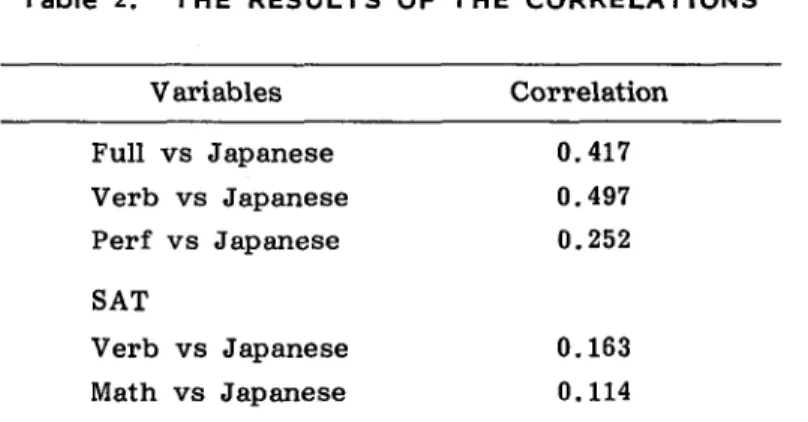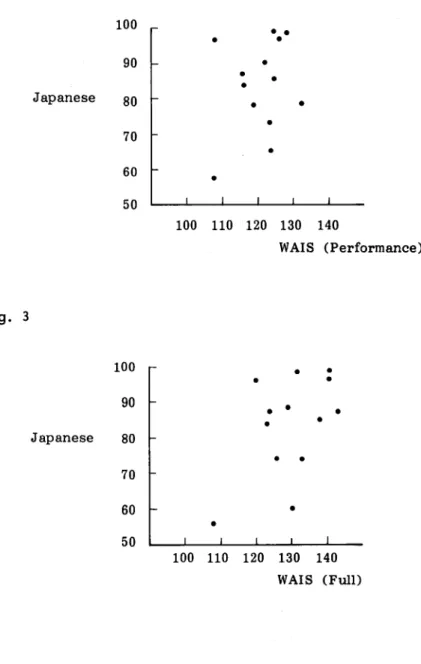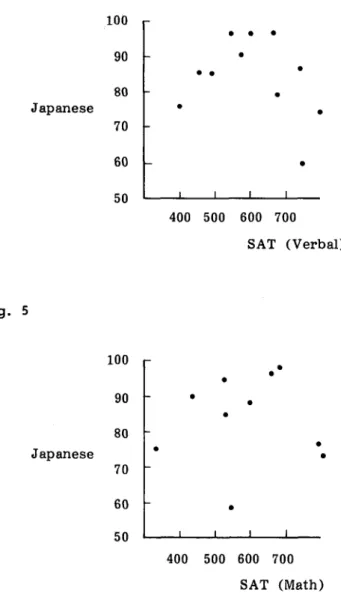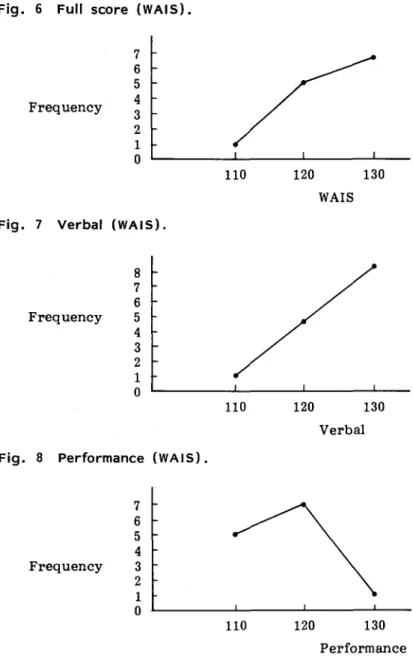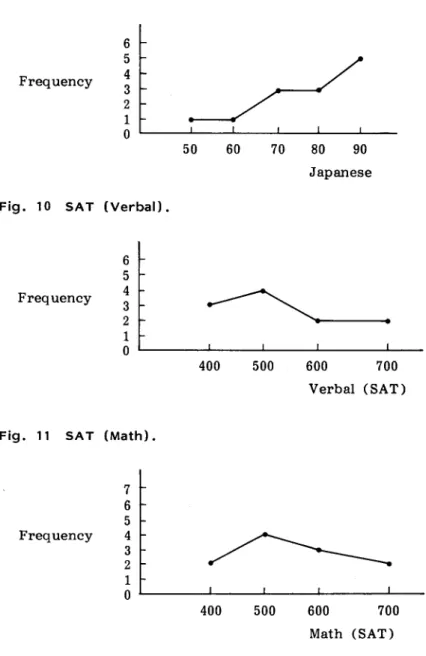AS
THE ACQUISITION
A SECOND LANGUAGE
OF JAPANESE
AND INTELLIGENCEi
by Yukiko
Kurato
l. INTORDUCTtON
Whether intelligenee has anything to do with language acquisition has been of interest to those who are involved in
language teaehing.
In one study, verbal intelligence measured by the
Modern Language Aptitude Test (MLAT) was diseovered to be
a most powerful trait associated with aehievement for learning
French (Gardner and Lambert, 1959). In another study, intel-ligence measured by an IQ test was related to the learning of Freneh in U.S. sehools (Pimsler, Mosberg and Morrison, 1962), although the above finding was only true of !ow level intelligence. Also, intelligence was correlated with language learning which was taught by cognitive-eode type methods when compared to audio-lingual methods (Chastain, 1969). A
high correlation was also found with Freneh for
English-speaking Canadian students (Genesee, 1978). On the other hand, one study showed that intelligenee
did not appear to be an important factor in the acquisition of
foreign language (Lambert and Tucker, 1972). In another study, motivation of the learners was more infiuential
(Gardner, 1959). Also, motivation and situation sueh as living in a bi-lingue.1 culture were more powerful factors (Jones and
-15-Larnbert, 1967).
Thus, there has not been consisteney in intelligenee
eorrelations with !ariguage acquisition.
Therefore, the present study was designed to investigate the relationship between Japanese language aequisition as a seeond language and intelligence. It was also hoped that the present study would provide some information concerning Japanese language teaehing to the present investigator who was involved in teaehing the language, since the results
would have highly significant implications.
'
lt. HYPOTHESIS
The hypothesis for the present study eonsisted of the following; Japanese language aequisition for English speak-ing eollege students would be correlated with their
intelli-genee.
111. PROCEDURES
Measurement: The measurement of Japanese language
ac-quisition was by the examination results tested at preliminary,
mid-term, and final examinations for the class of elementary Japanese2 at the University of Mssaehusetts. The course was taught and tested by Prof. Chisato Kitagawa of the Asian Study programs. The investigator was his graduate teaching assistant who was in charge of its honor's seetion. The three examinations consisted of grarnmer, listening comprehension,
eomposition, translation, and the examinations were all graded
in points.
Adult Intelligence Scale (WAIS). A WAIS was administered individually by the investigator during the Fal1 semester,
1974. The investigator was certified to administer the
Weehsler Intelligence Scale by Springfield College.
The WAIS is one of the most popularly used intelligent tests in most psychological and psychiatric clmies in the United States. Its oniginal edition was developed in 1939 by Dr. David Weehsler and his eolleagues in Bellevue Psychiatrie
Hospital, New York. One of the most outstanding
eharaeteristics that the WAIS has is its diagnostie power with
high reliability and validity (Wechsler, 1955). Another charaetenistic is the fact that it has' subseales: Verbal and
Perfoinmance together with Full seale.
The seale consists of eleven tests as follows:
Verbal Tests Performance Tests
Information Digit Symbol
Comprehension Pieture Completion
Arithmetic Bloek Design
Similarities Picture Arrangement
Digit Span Objeet Assembly
Vocabulary
SAT (Seholastie Aptitude Test) was also used for the
study in a hope that this measure would provide some
information on the matter concerned here. The SAT soores were voluntarily reported by the subjeets. The SAT was administered to most U.S. high sehool students who were candidates for colleges and universities. Therefore, the students were supposed to know the SAT scores.Subjects: The subjects chosen for this investigation were
13 students (5 males and 8 females) at the University of Massaehusetts, all taking Elementary Japanese #126. They 17
-were earefully seleeted from those who had not known
Japanese previously and had just started learning Japanese as a second language for the first time: Those who knew morethan ABC Japanese were excluded from seleetion. The
subjects rariged from 17 to 27 years old.Limitations: The present attempt was limited as follows:
1) No attempt was made to control the subjeets'
previous familiarity or baekground of Japanese language, Japanese people and culture exeept the fact mentioned in the procedure. It was hard to contro1 factors such as this, butthis might have been a critieal faetor for this sort of study.
2) Japanese language aequisition was limited to the test results (mean), and intelligenee was limited to the IQ measured by the WAIS.
3) It was also limited to the period of one semester.
IV. RESULTS
Table 1 shows the test results for Japanese language and the WAIS. For Japanese language aequisition, the mean of the three examinations was employed for comparison. For the I.Q., Full score and two subseores on the WAIS, that is, the Verbal and Performance scores, were used. And each of them was independently eompared with the mean of its Japanese test results. Since al1 sUbjects except two knew their SAT (verbal and mathematics) scores, These scores
were also compared with the mean of the Japanese test
results.A Peasonian correlation was caleulated among the
variables mentioned above, since the purpose of the studywas to see the relationship between Japanese language aequi-sition and intelligence. The formula for the Peasonian
eorrelation, r, is as follows:
nÅíxy -• zxzy r=
vfiSiiT:-7(Ei5-Tzx) zy2-(zy)2
where X=the test result (mean) ofJapanese
languageY =the WAIS seore/SAT score n = the number of the subjeets
The results are shown in Table 2 and Figs. 1- 5. None of the results of the present study indieated signifieant
correleation between the two variables.
Table 1. IQ. SAT AND JAPANESE RESULTS
Sub-jeet WAIS(Verb) (Perf) (Full)
SAT
(Verb)(Math)
JAPANESE
(1) (2) (3) (Mean)1 2 3 4 5 6 7 8 9 10 11 12 13 130 109 127 145 128 144 144 137 132 127 142 133 126 125 107 107 132 119 127 125 123 124 117 129 120 114 130 109 120 142 126 139 138 133 130 124 139 129 122 520 670 400 660 720 800 730 480 600 570 500 530 770 300 650 600 780 540 510 672 440 525 95 40 95 70 70 92 73 70 40 90 96 96 90 98 100 85 45 95 98 100 65 88 68 100 99 100 85 93 60 85 55 95 75 100 98 95 80 85 75 98 57 96 78 75 97 86 74 60 87 98 90 83
-19-Table 2. THE
RESULTS
OF THE
CORRELATIONS
Variables Correlation Full vs Japanese Verb vs Japanese Perf vs JapaneseSAT
Verb vs Japanese Math vs Japanese o o o o o . . . . . 417 497 252 163 114 Abbreviation used in Verbal, Perf: Performance,the Math: tables are as Mathematics. follows ; Verb: Fig. 1 Japanese 100 90 80 70 60 50 . . . e . . . . e ee . . 100 110 120 130 WAIS 14e (Verbal)
-20-Fig. 2 Japanese 100 90 80 70 60 50 . . . . . .
ee
. . . . . 100 110 120 130 WAIS 140 (Performance) Fig. 3 Japanese 100 90 80 70 60 50 e eee
. . . . . . . . . 100 110 120 130 WAIS 140 (Full) 21-Fig. 4 100 90 80 Japanese 70 60 50 .
ee
ee
. . . . . . 400 500 600 700 SAT (Verbal) Fig. 5 Japanese 100 90 80 70 60 50 400 500 600SAT
. . 700 (Math)-22-V. DISCUSSION
As shown in the results (illustrated in Figures 1 - 5), the hypothesis of the present study was not successfully confirmed. In other words, Japanese language aequisition measured by the three examinations at preliminary, mid-term,
and final was not correlated with intelligenee measured by the
WAIS. Why? To answer this question, it would be necessary to examine the following, since there seemed to be many
factors which might have affected the results.
First, the number of subjeets for the present study was a little bit smal1. To perform a safer investigation, the
number of subjeets should have been inereased. In the
present study, however, it was impossible beeause all the subjeets that the investigator eould sample in the class were used. This smallness of the sample might have infiuenced the results sinee there was not appropniate distribution in theirvariation in both the language test results and intelligence.
That is, the present sample deviated slightly from what is known as a normal distribution: There was a tendency to rise up in the night-hand side of the frequeneies exeept in the performanee tests in the WAIS.
-23-Fig. 6 Full score (WAIS). Frequeney 7 6 5 4 3 2 1 o 110 120 WAIS 130
Fig. 7 Verbal (WAIS).
Frequeney 8 7 6 5 4 3 2 1 o 110
120 130
VerbalFig. 8 Performance (WAIS).
Frequeney 7 6 5 4 3 2 1 o 110
120 130
Performanee-24-Fig. 9 Japanesetest results (mean). Frequency Fig. 10
SAT
6 5 4 3 2 1 o (Verbal) . 50 60 7080 90
Japanese Frequency 6 5 4 3 2 1 o 400 500 600 Verbal 700 (SAT)Fig. 11
SAT
(Math).Frequency 7 6 5 4 3 2 1 o 400 500 600 Math 700 (SAT)
The test results of Japanese language might have
depended upon such faetors as follows. How much and how seniously the subjects prepared for eaeh test. For instanee, there were 5 subjects (among 13 subjeets) whose scores were not stabilized for each test:Subjeet The lst Mid-term Finai
No.4 70 100 65
No.7 73 100 85
No.8 70 93 60
No. 10 90 95 75
No. 13 90 85 75
Therefore, these unstabilized results might be due to the
fact that students differed at eaeh test in their efforts. At
the same time, this might lead us to question whether the test
was well equipped to measure the degree of language
aequisition, beeause the tests were arbitrarily made up not having been eonstructed with a statistically standardized procedure and hence the test results did not show what is
known as a normal distribution.
After al1, the present study might be supporting the
other finding that there may be no direct re!ationship between
language acquisition and intelligence (Lambert and Tueker,
1972). The subject's motivation or situation (environment) may
be a better related faetor (Gardner, 1959; Jones and
Larnbert, 1967; Feenstra, 1968). However, this faetor was notineluded in the present study.
In order to examine the above, a follow-up study will be
needed as follows:
1) Motivation needs to be investigated: This may be
-26-done by interviewing the subjeets to see why they want to learn Japanese language. On the other hand, a projeetive test that can assess the subjeets' basic motivation will be very helpful. The Pieture Arrangement Test (Tomkins, 1959) will
be one possibility of this kind. •
2) A ease study of eaeh subjeet would be usefu1, such
that the subjects' interest and preparation for the class will
be explored: For instance, does each subject like the elass? How mueh time does eaeh subject spend for the elass and for
the examinations?
3) A long-term fol!ow-up study would be helpful to see the eoncerned relationship: The present results were only based on the findings of one semester period. Therefore, a year or two year-long follow-up of the language acquisition
would be very helpful for assessing the concerned matter.
4) The number of subjects must be increased in order
to infer safer and more reliable eonelusions.
On the other hand, some faetors language teachers might
eontribute in relation to students language aequisition should be exarnined in future studies; for instance, teaching skill or style might be an important faetor.
In addition, whieh eomponent of Japanese, i.e., listening
comprehension, structure, reading eomprehension, vocabulary
or writing, is related to intelligenee should be investigated.
NOTES
1) This paper was originally submitted as an independent study to the University of Massaehusetts in 1974.
2) Course #126 Elementary Japanese in Asian Study Prograrns
at the University of Massaehusetts, Fal1 semester, 1974.
BIBLIOGRAPHY
Chastain, K. 'Predietion of sueeess in audio-lingual and cognitive classes,' Language Learning, Vol. 19, pp. 27 39, 1969.
Feenstra, H. J. 'Aptitude, attitude and motivation in language acquisition,' Unpublished doctoral dissertation,
University of Western Ontanio, 1968.
Gardner, R. C. and Lambert, W. E. 'Motivational variables in
second language aequisition,' Canadian Journal of
Psychology, Vol. 13, No. 4, pp. 266 - 272, 1959.Genesee, F. 'The role of intelligence in seeond language learning,' Language Learning, Vol. 26, No. 2, pp. 267
280, 1978. .
Jones, F. E. and Lambert, W. E. 'Some situational infiuences on attitudes toward immigrants,' British Journal of Sociology, 18, pp. 408 - 424, 1967.
Lambert, Wl E. and Tucker, G. R. Bilingual Education of Children, Mass: Newbury House, 1972.
Pimsleur, P., Mosberg, L., and Morrison, A. L. 'Student faetors in foreign language learning,' Modern Language
Journal, Vol. 46, pp. 160 -- 170, 1962.
Tomkins, S. Tomkins-Horn Picture Arrangement Test, N.J.: Spninger Publishing, 1959.
-28-Weehsler,
The
D. Wechsler Psychologieal Adult Intelligence Corporation, 1955.Scale ,
New
York/(Received May 12, 1986)
